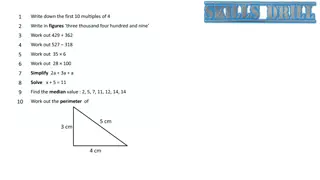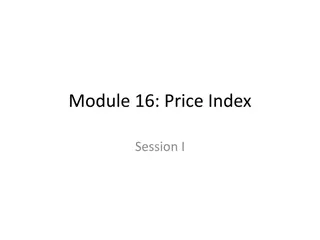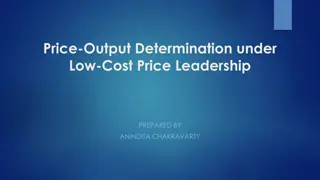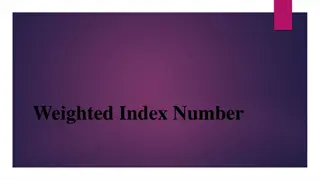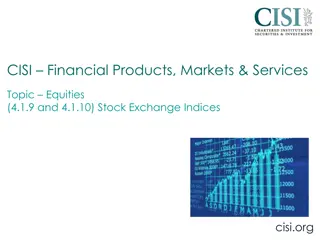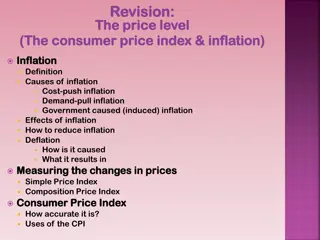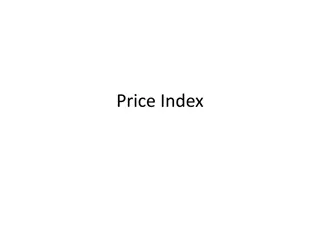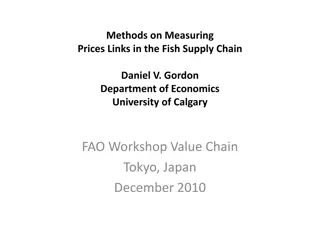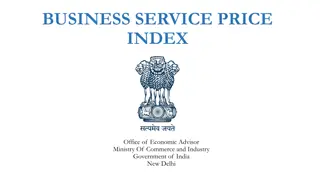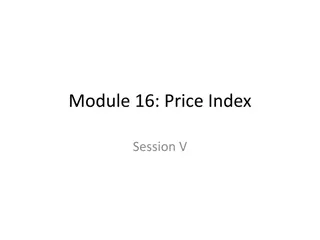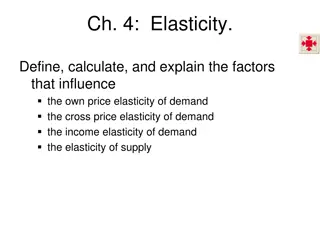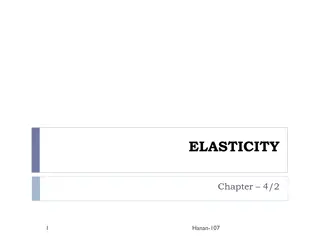Understanding Price Indices in Economics
Exploring the concept of price indices in economics, focusing on composite price indexes, weighted and unweighted indices, and their importance in measuring relative prices. A practical illustration using the example of tea consumption showcases how price indices help in understanding cost changes over time. The solution demonstrates calculating the cost of morning tea based on fixed quantities and price fluctuations.
Download Presentation

Please find below an Image/Link to download the presentation.
The content on the website is provided AS IS for your information and personal use only. It may not be sold, licensed, or shared on other websites without obtaining consent from the author. Download presentation by click this link. If you encounter any issues during the download, it is possible that the publisher has removed the file from their server.
E N D
Presentation Transcript
Module 16: Price Index Session II
Contents Session II Composite Price Index Unweighted composite index Weighted composite index Important terms Base period (year): price reference period, weight reference period and index reference period Elementary aggregates (Expenditure) weights Consumption basket Price relatives and relative prices Price updating 2
Composite Index numbers Why Price Indices? An Illustration Assume that you have a habit of taking tea in the morning and price of tea leaves (your preferred variety) is 1.2 times in the current month (in 2012) as compared to its average price in 2010. As compared to the average of 2010, how much does your morning cup of tea cost you in the current month, A. if you drink black tea, i.e. without cream and sugar? B. if you drink tea with cream and sugar?
Composite Index numbers Why Price Indices? (2) Yes, the answer to part A of the question is 1.2 times. Can you answer part B with the given information? To answer part B, we need more information. What are they? We need to know i. the quantities of tea, cream and sugar you use for your cup of morning tea, ii. ratios of average prices of cream and sugar with respect to average price of tea leaves in 2010 and iii. ratios of prices of cream and sugar in the current month as compared to corresponding average prices in 2010.
Composite Index numbers Why Price Indices? (3) a. From (i) and (ii) we can work out the average cost of your morning tea in 2010. In addition, using (iii) we can work out the cost in the current month. The ratio of (b) to (a) will be the answer to part B. b.
Composite Index numbers Example 5 (fixed quantities) products quantity (gms.) / price / cost total tea leaves sugar cream 1.0 2.5 0.5 quantity (gms.) for one cup average price (per gm.) in 2010 15 4 10 price (per gm.) in current month 20 6 20 ? ? 30 45 ? ? ? 5 15 10 cost in 2010 Calculate the costs in your workbook. ? ? ? cost in current month 20 15 10
Composite Index numbers Example 5 Solution (Contd.) Thus the answer to part B will be 45/30 = 1.5 That is, as compared to the average of 2010, the cup of morning tea cost you 1.5 times in the current month OR if it was 100 in 2010, in the current month it is 150. We say, the price index (base year: 2010) for the ingredients of your morning tea is 150 in the current month.
Composite Index numbers Example 6 (changing quantities) products quantity (gms.) / price / cost total tea leaves sugar cream 0.9 3.0 0.6 quantity (gms.) per cup in 2010 1.0 2.5 0.5 quantity (gms.) per cup in 2011 quantity (gms.) per cup in current month 1.2 2.0 0.4 15 4 10 average price per gm. in 2010 20 6 20 price (per gm.) in current month 13.5 ? 12 ? 6 31.5 ? ? 44 ? cost in 2010 Calculate the costs in your workbook. ? 24 ? 12 ? 8 cost in current month
Composite Index numbers Example 6 Solution (Contd.) Thus, the cup of tea in the current month is costlier than 2010 by 44 / 31.5 = 1.40 times. That is, as compared to the average of 2010, the morning cup of tea cost you 1.4 times in the current month But this rise in cost is not just for price rise. The change in the quantities required per cup is also responsible.
Composite Index numbers Example 6 Solution (Contd.) Thus, to get a measure of change in prices, we must keep the quantities constant. The question is which time period s quantities should we consider for that purpose? quantities of 2010 OR quantities of 2011 OR quantities of the current period?
Composite Index numbers Example 7 Solution with 2011 quantities products quantity (gms.) / price / cost total tea leaves sugar cream 0.9 3.0 0.6 quantity (gms.) per cup in 2010 1.0 2.5 0.5 quantity (gms.) per cup in 2011 quantity (gms.) per cup in current month 1.2 2.0 0.4 15 4 10 average price per gm. in 2010 20 6 20 price (per gm.) in current month ? 30 ? ? ? 5 cost in 2010 for 2011 quantities 15 10 Calculate the costs in your workbook. cost in current month for 2011 quantities ? 45 ? ? ? 20 15 10
Composite Index numbers A Price Index In Example 7, using fixed (2011) quantities, the ratio of costs in the current period (2012) and 2010 gives us a measure of price change 1.5 times. This gives the general expression of the most commonly used measure of price index. = ib i q p . 0 Algebraically, q . p it ib i I i ot qib represents quantity of ith product in bth period pit represents price of ith product in tth period pi0 represents price of ith product in base period where
Composite Index numbers Lowe Price Index The Lowe price index is a type of index in which the quantities are fixed and predetermined. i q . p it ib = I i ot q . p 0 i ib Many of the indices produced by statistical agencies turn out to be Lowe indices. We will discuss this further in the next session.
Composite Index numbers Some important terms Price Index for a cup of tea This is an example of computing price index for a simple mix of products needed for a cup of tea of one person. The ratio of costs of the current period and that of 2010 gives us i i q . p it ib = I ot q . p 0 i ib is the price index for the current month (t), with 2010 as the reference period (0) and quantities of the 2011 (b). In the context of price index, such reference period is called the base period denoted by suffix 0 in the formula.
Composite Index numbers Some important terms Price Index an alternative expression = i q p . 0 q . p it ib i I Note that can also be written as i ot ib ??? ??0 ?? ??0??? ???0??? ?0?= ? where ??= In the context of CPI, wi s are called expenditure weights. In Example 5, weights are as follows: products weight / cost total tea leaves sugar cream 30 15 10 5 cost in 2010 for 2011 quantities Weight (wi) 1 0.5 0.33 0.17
Composite Index numbers Some important terms What is Consumer Price Index (CPI)? Conceptually, CPI is similar to the price index for a cup of tea, only that in practice, The price index is compiled for all the residents of an economy or a well-defined segment of it [not a single person as in the example]; the set of products for consumption is very large including all goods and services consumed by residents or a segment of them, and average of prices collected from a sample of sellers of the product is used for compilation of the index.
Composite Index numbers Some important terms Consumption Basket The very large set of products are used for compilation of CPI. Each individual product has a share in the total value of consumption expenditure, which is the expenditure weight of the product. Consumption Basket: the set of goods and services for which an index of price change is constructed, along with their expenditure weights. In our example, the consumptionbasket is composed of tea leaves (your preferred variety), sugar and cream, along with their respective weights 0.5, 0.33 & 0.17.
Composite Index numbers Some important terms Base period The base period generally is understood to be the period with which other periods are compared. The values of expenditure in the base year provide the basis of assigning weights for a price index. However, the concept of the base period is not a precise one and may be used to mean rather different things.
Composite Index numbers Some important terms Base period three types Three types of base periods may be distinguished: i. the price reference period, that is, the period whose prices appear in the denominators of the price relatives used to calculate the index, or ii. the weight reference period, that is, the period, usually a year, whose values serve as weights for the index. However, when hybrid expenditure weights are used in which the quantities of one period are valued at the prices of some other period, there is no unique weight reference period, or iii. the index reference period, that is, the period for which the index is set equal to 100. The three reference periods may coincide but frequently do not.
Composite Index numbers Some important terms Example 8 with three different base periods products weights / price total tea leaves sugar cream weights in 2009 wi09 0.9 3.0 0.6 1.0 15 4 10 average price per gm. in 2010 17 5 15 average price per gm. in 2011 20 6 20 price (per gm.) in current month (weights in 2009)*(price relatives in 2010) 0.4412 0.2400 0.1333 0.8145 Calculate the values in your workbook. (weights in 2009)*(price relatives in current month) 0.5882 0.3600 0.2667 1.2149 Index reference period 2010; Weight reference period 2009 and Price reference period - 2011
Composite Index numbers Some important terms Example 8 (contd.) The ratio 100*(weights in 2009) (price relatives in current month) (weights in 2009) (price relatives in 2010) = 100 1.2149 0.8145= 149.2 gives the required price index for the current month.
Composite Index numbers Some important terms Some more important terms The ratios of prices of products (like tea, cream and sugar in 2010) is called relative prices. For each individual product, the ratios of prices in the current period to those of the base year is called price relatives. Combining the information on quantities and relative prices, we assign weights or expenditure weights to each product in the basket.
Composite Index numbers Some important terms Price Comparison ti p price of ith commodity at tth time point : Relative Price: of ith commodity w.r.t. jth commodity at tth time point tip p tj Price relative: of ith commodity between base period and the tth time point tip p 0 i 25
Composite Index numbers Some important terms (Expenditure) Weights A set of numbers, between zero and one, that sum to 1. The weights are used to obtain price indices or higher level indices by averaging the elementary price indices. Weights (wi) of all the goods and services included in the basket should add up to 1. That is ???= 1. 26
Composite Index numbers Some important terms Elementary aggregates The lowest level of aggregation for which value data are available and used in the calculation of a price index are called elementary aggregates. In our example of a cup of tea , each of the three items tea leaves, sugar and cream are elementary aggregates. Each elementary aggregate is assigned separate weights. 27
Composite Index numbers Some important terms Elementary Price Index An elementary price index is a price index for an elementary aggregate. In practice, a number of price observations on different varieties and from different sellers are taken and the elementary price index is calculated from individual price observations without using weights. More generally, the term is used to describe any price index that is calculated without weights. 28
Composite Index numbers Some important terms Price updating of weights Usually, the weight reference period precedes the price reference period. Price-updating is done by multiplying the elementary aggregate expenditure shares by the corresponding elementary price indices b 0
Composite Index numbers Some important terms Example 9: Price updating of weights As we will later on see, CPI weights are obtained from results of a household consumption expenditure survey (HCES). In the present example, the HCES is conducted with 2008 as the reference period, while the index reference period is 2010. products weight / cost total A B C Weight (wi08) in 2008 Prices (pi08) in 2008 Prices (pi10) in 2010 1.0 0.5 0.3 0.2 13 4 11 15 5 10 Price relatives 2008 2010 (pr) 1.15 1.25 0.91 pr * wi08 Updated weights (wi) for 2010 0.58 0.38 0.18 1.13 Calculate the values in your 0.509 workbook. 0.331 0.160 1.00





